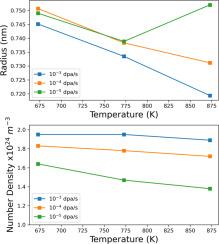Kinetic Monte Carlo modelling of nano-oxide precipitation and its associated stability under neutron irradiation for the Fe-Ti-Y-O system
IF 11.2
1区 材料科学
Q1 MATERIALS SCIENCE, MULTIDISCIPLINARY
引用次数: 0
Abstract
While developing nuclear materials, predicting their behavior under long-term irradiation regimes spanning decades poses a significant challenge. We developed a novel Kinetic Monte Carlo (KMC) model to explore the precipitation behavior of Y-Ti-O oxides along grain boundaries within nanostructured ferritic alloys (NFA). This model also assessed the response of the oxides to neutron irradiation, even up simulated radiation damage levels in the desired long dpa range for reactor components. Our simulations investigated how temperature and grain boundary sinks influenced the oxide characteristics of a 12YWT-like alloy during heat treatments at 1023, 1123, and 1223 K. The oxide characteristics observed in our simulations were in good agreement with existing literature. Furthermore, the impact of grain boundaries on precipitation was found to be minimal. The resulting oxide configurations and positions were used in subsequent simulations that exposed them to simulated neutron irradiation to a total accumulated dose of 8 dpa at three temperatures: 673, 773, and 873 K, and at dose rates of , , and dpa/s. This demonstrated the expected inverse relationship between oxide size and dose rate. In a long-term irradiation simulation at 873 K and dpa/s was taken out to 66 dpa and found the oxides in the vicinity of the grain boundary were more susceptible to dissolution. Additionally, we conducted irradiation simulations of a 14YWT-like alloy to reproduce findings from neutron irradiation experiments. The larger oxides in the 14YWT-like alloy did not dissolve and displayed stability similar to the experimental results.

中子辐照下Fe-Ti-Y-O体系纳米氧化物沉淀及其相关稳定性的动力学蒙特卡罗建模
在开发核材料的过程中,预测其在数十年长期辐照条件下的行为是一项重大挑战。我们开发了一种新颖的动力学蒙特卡罗(KMC)模型,用于探索纳米结构铁素体合金(NFA)中 Y-Ti-O 氧化物沿晶界的析出行为。该模型还评估了氧化物对中子辐照的响应,甚至模拟了反应堆部件所需的长 dpa 范围内的辐射损伤水平。我们的模拟研究了在 1023、1123 和 1223 K 下进行热处理时,温度和晶界汇如何影响 12YWT 类合金的氧化物特性。此外,我们还发现晶界对析出的影响微乎其微。在随后的模拟中使用了所得到的氧化物构型和位置,并在三种温度下将其暴露于总累积剂量为 8 dpa 的模拟中子辐照:673、773 和 873 K,剂量率分别为 10-310-3、10-410-4 和 10-510-5 dpa/s。这表明氧化物大小与剂量率之间存在预期的反比关系。在 873 K 和 10-310-3 dpa/s 的长期辐照模拟中,辐照剂量为 66 dpa,结果发现晶界附近的氧化物更容易溶解。此外,我们还对 14YWT 类合金进行了辐照模拟,以重现中子辐照实验的结果。14YWT 类合金中较大的氧化物没有溶解,显示出与实验结果类似的稳定性。
本文章由计算机程序翻译,如有差异,请以英文原文为准。
求助全文
约1分钟内获得全文
求助全文
来源期刊

Journal of Materials Science & Technology
工程技术-材料科学:综合
CiteScore
20.00
自引率
11.00%
发文量
995
审稿时长
13 days
期刊介绍:
Journal of Materials Science & Technology strives to promote global collaboration in the field of materials science and technology. It primarily publishes original research papers, invited review articles, letters, research notes, and summaries of scientific achievements. The journal covers a wide range of materials science and technology topics, including metallic materials, inorganic nonmetallic materials, and composite materials.
 求助内容:
求助内容: 应助结果提醒方式:
应助结果提醒方式:


